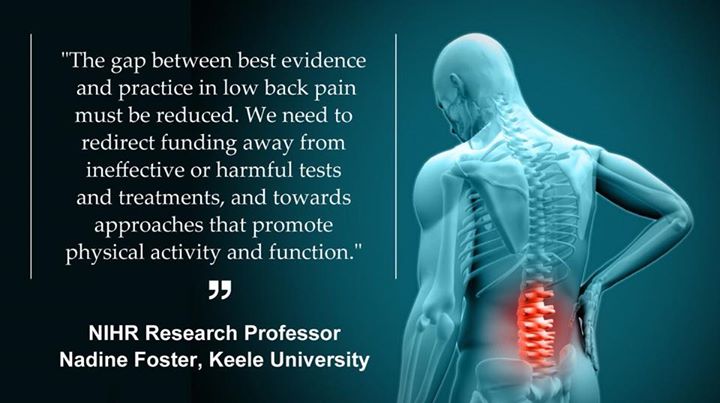Lancet Series: Low Back Pain

The Lancet has published a series of three papers on the global impact of low back pain that present the challenges and causes of low back pain; the evidence for the effectiveness of treatments and a call for action.
- What low back pain is and why we need to pay attention
This paper discusses the many contributing factors to low back pain and disability; potential nociceptive contributors to low back pain that have undergone investigation and the burden and impact of low back pain on society and economically.
Summary (link below in separate page)
- Low back pain is an extremely common symptom in populations worldwide and occurs in all age groups, from children to the elderly population
- Low back pain was responsible for 60·1 million disability-adjusted life-years in 2015, an increase of 54% since 1990, with the biggest increase seen in low-income and middle-income countries
- Disability from low back pain is highest in working age groups worldwide, which is especially concerning in low-income and middle-income countries where informal employment is common and possibilities for job modification are limited
- Most episodes of low back pain are short-lasting with little or no consequence, but recurrent episodes are common and low back pain is increasingly understood as a long-lasting condition with a variable course rather than episodes of unrelated occurrences
- Low back pain is a complex condition with multiple contributors to both the pain and associated disability, including psychological factors, social factors, biophysical factors, comorbidities, and pain-processing mechanisms
- For the vast majority of people with low back pain, it is currently not possible to accurately identify the specific nociceptive source (i.e disc vs facet joint)
- Lifestyle factors, such as smoking, obesity, and low levels of physical activity, that relate to poorer general health, are also associated with occurrence of low back pain episodes
- Costs associated with health care and work disability attributed to low back pain vary considerably between countries, and are influenced by social norms, health-care approaches, and legislation
- The global burden of low back pain is projected to increase even further in coming decades, particularly in low-income and middle-income countries
[embeddoc url=”https://www.mygcphysio.com.au/wp-content/uploads/2020/02/What-low-back-pain-is-and-why-we-need-to-pay-attention-1.pdf” download=”all” viewer=”google”]
2. Prevention and treatment of low back pain: evidence, challenges, and promising directions
This paper summarises the evidence for and against various options at treating and preventing low back pain; the gap between current practice and guideline recommendations; and promising directions for the improved management of low back pain globally into the future.
Summary (link below in separate page)
- Guidelines recommend self-management, physical and psychological therapies, and some forms of complementary medicine, and place less emphasis on pharmacological and surgical treatments; routine use of imaging and investigations is not recommended
- Little prevention research exists, with the only known effective interventions for secondary prevention being exercise combined with education, and exercise alone
- The evidence for prevention and treatment comes mainly from adults in high-income countries and whether the resulting recommendations are appropriate for children or those in low-income and middle-income countries is not known
- Non-evidence-based practice is apparent across all income settings; common problems are presentations to emergency departments and liberal use of imaging, opioids, spinal injections, and surgery
- Promising solutions include focused implementation of best practice, the redesign of clinical pathways, integrated health and occupational care, changes to payment systems and legislation, and public health and prevention strategies
- The evidence underpinning these solutions is inadequate and whether they are appropriate for widespread implementation is not known
- Further testing of these promising solutions, and development of new solutions, is needed, particularly in low-income and middle-income countries
Full Text (PDF)
3. Low back pain: a call for action
This viewpoint panel explores the most pressing political, public health, and health-care challenges and identifies actions to meet them.
Summary (link below in separate page)
Key Messages:
- Use the notion of positive health—the ability to adapt and to self-manage in the face of social, physical and emotional challenges—for the treatment of non-specific low back pain
- Avoid harmful and useless treatments by adopting a framework similar to that used in drug regulation—ie, only include treatments in public reimbursement packages if evidence shows that they are safe, effective, and cost-effective
- Address widespread misconceptions in the population and among health professionals about the causes, prognosis, and effectiveness of different treatments for low back pain, and deal fragmented and outdated models of care
- Policy, public health, health-care practice, social services, and workplaces must jointly tackle the low back pain paradox in low-income and middle-income countries, where improving social and economic conditions could prevent or reduce low back pain incidence, but at the same time create expectations and demands for medical investigations and low-value health care that increase the risk of long-term back-related disability
Full Text (PDF)

































